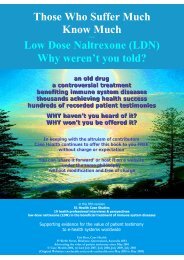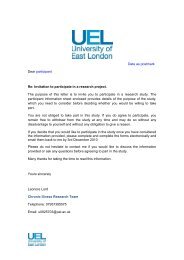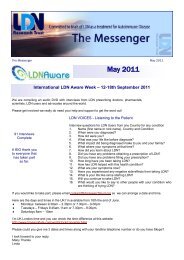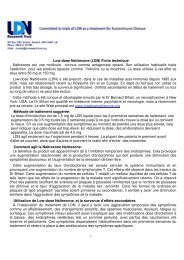After a number of days of worsening symptoms the angiogram was deferred and furthertests carried out. These showed a continuing infection with no resolution of thesepticaemia. After trying a second antibiotic, when the infection again appeared topersist it was deduced that the likely fixed source of the infection was the cannula itself.This was duly removed and my temperature, and the infection, resolved within twentyfourhours. I continued the antibiotic for a few more days to ensure completeeradication of the infection, when the angiogram was at last booked and carried out.This showed only moderate narrowing of some of the branch arteries of the coronarycirculation and I was offered two drugs, one a calcium antagonist, and the other a betablocker.I soon became aware of the dramatic side-effects of the beta-blocker when mysleep became grossly disturbed, with bizarre dreams for the maximum of two hourssleep I would attain, plus daytime hallucinations that made me wonder if I was actuallyawake or not!The beta-blocker was thus changed for one that did not cause these strange sideeffectsand I was finally discharged home.After some days I became aware that the drugs, although temporarily effective inreducing the pain, had no prolonged effect in preventing its recurrence. I thereforesurmised that, as I was already taking a moderate dose of vitamin E, a potentvasodilator, and that the nature of the angina could be due to vasospasm of the arteriesof the heart, I might gain a significant benefit by doubling my dose of this simplevitamin. I promptly increased the dose from 400iu to 800iu, when almost instantly,within just a couple of days, the pain had gone entirely.I abandoned both the drugs, that had proved so ineffective, and I have continued withthis high dose of vitamin E with no further recurrence of the pain ever since.My logic, and the results I obtained, were later reaffirmed by a study at AddenbrookeHospital in Cambridge, conducted in 1996, when a double blind, placebo controlled trialof a single daily dose of vitamin E, 400iu, in patients already having suffered a heartattack, showed a 79% reduction in further risk by taking this simple vitamin.I continued my work, now gradually limiting the range of problems I chose to deal with.Eventually, I was dealing almost entirely with just MS, plus a few related conditions,such as colitis or rheumatoid arthritis.Slowly, as my work increased, my reputation grew and, by 1997, as I had begun tomake increasing use of the internet, I had become sufficiently well known to be able tostop advertising entirely and just rely on word-of-mouth recommendations to gathernew inquiries.It was this connection with the internet that was to later reveal the final link in thetreatment regime that was to complete the stability of my MS.This was the discovery, in late 2000, of low-dose naltrexone (<strong>LDN</strong>), a method initiallyapplied in significant numbers by Dr Bernard Bihari, a New York physician. At that timeDr Bihari was treating about 70 patients with a variety of complaints, by this treatmentmethod.Produced by <strong>LDN</strong> Research Trust for <strong>International</strong> <strong>LDN</strong> <strong>Awareness</strong> <strong>Week</strong> 19-25 October 2009© <strong>LDN</strong> Research Trust 200930
On first reading mention of this apparently simple method, first noted in the web forumof an internet advisor referred to as ‘Goodshape’, (actually an ex American Airforcedoctor), I was naturally suspicious of its claims.I therefore spent more than a year both investigating and testing the method by firstobtaining a supply of the drug in 50 mg tablet form. I also obtained from themanufacturer, Dupont, a list of research references describing the various ways inwhich a liquid preparation could be prepared.Choosing the most suitable method, which gave a stable suspension, with anappropriate shelf-life of about 60 days (when stored at 4 deg C or below) I finallystarted testing this on myself over a number of months.After some initial difficulty by the chemist in preparing the mixture I was able toestablish a regular supply, which I used over a period of several months. Afterconfirming its response and freedom from side-effects I later made the decision to order5000 capsules from Bigelow Pharmacy in New York. These were initially all at a doseof 4.5 mg, and with lactose filler, as advised by Dr Bihari.I publicised details of the method in New Pathways, the bimonthly magazine of the MSResource Centre. This article was published in issue 15, Sept-Oct, 2002, which, onpublication, heralded a torrent of new inquiries, which initially, I found both encouragingand flattering. Obviously, I was not the only one who had heard of <strong>LDN</strong>.Within weeks it was obvious that I would need to order a further supply. I thereforestarted placing repeat orders so that I could maintain an ongoing supply for thosealready on the treatment. The numbers treated slowly increased and so the size of the<strong>LDN</strong> orders also necessarily increased in proportion. It soon became obvious that theinitial dose of 4.5 mg was not suitable for everyone so I later also requested anadditional supply of 3 mg.A further problem also became obvious when a significant number of patients started tocomplain of muscle or joint pain within weeks of starting the treatment. This, Isurmised, was due to the use of lactose filler and so I arranged for this to be replacedby calcium carbonate. This appeared to resolve the problem so I continued with thisfiller for several years with no complaints.I also changed my supplier to Irmat Pharmacy when, on investigation, it becameobvious that their prices were significantly lower than my previous supplier.Continuing and increasing both the use of <strong>LDN</strong> and the range of problems that it mightbe used for I slowly increased the range of doses to provide six different sizes,including 1,2, 3, 3.7, 4.5, and finally, 6 mg.The very low doses were used in the few cases that remained intolerant to the usualrange from 3 to 4.5 mg. Only rare exceptions, about 0.5% of all those treated, wereable to gain benefit from the extreme 6 mg dose.Following some discussion on the internet suggesting that calcium carbonate filler wassubject to clumping, thus reducing the rate of absorption of the drug, I later changed thefiller to Avicel (methyl cellulose), an inert filler.Produced by <strong>LDN</strong> Research Trust for <strong>International</strong> <strong>LDN</strong> <strong>Awareness</strong> <strong>Week</strong> 19-25 October 2009© <strong>LDN</strong> Research Trust 200931
- Page 1 and 2: 100REASONSWHYYOU SHOULDKNOW ABOUTLD
- Page 3 and 4: STORYNUMBERCONTENT CONDITION PAGELi
- Page 5 and 6: 95 Vicki F, USA Multiple Sclerosis
- Page 7 and 8: 1Adrian, UKApril 2005 - Secondary P
- Page 9 and 10: Over the years I was given no medic
- Page 11 and 12: I was very run down and tired, and
- Page 13 and 14: I've just taken Syd on a walk by my
- Page 15 and 16: 6Atif A, ScotlandNovember 2005 - Mu
- Page 17 and 18: If I went for a walk it was like th
- Page 19 and 20: 8Bev K, USA2004 - Multiple Sclerosi
- Page 21 and 22: The back pain was the first indicat
- Page 23 and 24: I later noticed, when completing an
- Page 25 and 26: For three days we lived on sandwich
- Page 27 and 28: This had been opened and equipped w
- Page 29: presented to me and offering advice
- Page 33 and 34: Videos of all the talks and other l
- Page 35 and 36: time it rained. I can stand in line
- Page 37 and 38: I fall asleep as soon as my head hi
- Page 39 and 40: are her main symptoms. She is affec
- Page 41 and 42: After a few weeks of taking LDN, I
- Page 43 and 44: (1) I still suffer from tiredness a
- Page 45 and 46: I was started on beta-interferon be
- Page 47 and 48: 20Crystal N, USANov 2004 - Secondar
- Page 49 and 50: After I was diagnosed with Secondar
- Page 51 and 52: 22David N, UK1995 - Multiple Sclero
- Page 53 and 54: I went looking for alternative trea
- Page 55 and 56: 26Dianne W, AustraliaOct 1986 - Rel
- Page 57 and 58: then I pay for a month’s supply o
- Page 59 and 60: The doctor had no information for m
- Page 61 and 62: us make significant decisions for o
- Page 63 and 64: The improvement was so very gradual
- Page 65 and 66: 33Francie S, USASept 2000 - Multipl
- Page 67 and 68: At around this time, my husband was
- Page 69 and 70: There was no real explanation from
- Page 71 and 72: 38Jay D, UK2001 - Multiple Sclerosi
- Page 73 and 74: stories of how they had patients th
- Page 75 and 76: 41Jeni S, UK1997 - Diagnosed plaque
- Page 77 and 78: to speak honestly of our experience
- Page 79 and 80: 45John O, UK24 July 2000 - Secondar
- Page 81 and 82:
More recently, I've been having Hyp
- Page 83 and 84:
49Joyce C, USA2001 - Hepatitis BJul
- Page 85 and 86:
to treat children with Autism. We r
- Page 87 and 88:
This is one of the end goals of the
- Page 89 and 90:
50Judy H, USAOctober 1995 - Fibromy
- Page 91 and 92:
The first night I did fine. No drea
- Page 93 and 94:
50mg tablet to fine powder between
- Page 95 and 96:
ut she also did not say too much ex
- Page 97 and 98:
I agreed to start on Copaxone injec
- Page 99 and 100:
een prescribed some cream made from
- Page 101 and 102:
56Linda Elsegood, UKOct 2000 - Rela
- Page 103 and 104:
Six weeks later I was given another
- Page 105 and 106:
Mum survived, even though a third o
- Page 107 and 108:
I was having a relapse every 6 mont
- Page 109 and 110:
At this point I couldn't feel any o
- Page 111 and 112:
agreed to refer me, but said I prob
- Page 113 and 114:
This position also gives me full ac
- Page 115 and 116:
The internet is a great tool and if
- Page 117 and 118:
Importantly, she can now hold a mug
- Page 119 and 120:
Until four or five years ago it was
- Page 121 and 122:
65Michelle X, UKApril 2004 - Multip
- Page 123 and 124:
I have not had the strange dreams o
- Page 125 and 126:
I actually took a paperclip (workin
- Page 127 and 128:
Life was good, but I knew it could
- Page 129 and 130:
68Nikolaos P, UKMarch 2007 - Multip
- Page 131 and 132:
I restarted taking LDN about a year
- Page 133 and 134:
intent of tapering down to 3mg dail
- Page 135 and 136:
In January 2008, our son started on
- Page 137 and 138:
75Paul C, UK2004 - Multiple Scleros
- Page 139 and 140:
78PN - ANON, UK2006 - Primary Progr
- Page 141 and 142:
I have now been on LDN for almost a
- Page 143 and 144:
I’d done a lot of research becaus
- Page 145 and 146:
had her on worked against her. She
- Page 147 and 148:
promoted as healthy). Seems that my
- Page 149 and 150:
I have been taking LDN for almost o
- Page 151 and 152:
MS is part of my life but I have a
- Page 153 and 154:
87Steve W, UK20th Sept 2001 - Relap
- Page 155 and 156:
Having spent 25 years soldiering an
- Page 157 and 158:
left eye was permanently damaged. T
- Page 159 and 160:
Since restarting LDN, bladder probl
- Page 161 and 162:
My husband retired August 2002 and
- Page 163 and 164:
from wishful thinking, but hoped so
- Page 165 and 166:
used my foot for the car brake as w
- Page 167 and 168:
94Vickie A, USADecember 2006 - Mult
- Page 169 and 170:
95Vicki F, USA1998 - Progressive Re
- Page 171 and 172:
after 9 years, no longer on any ant
- Page 173 and 174:
96Wanda L, CanadaJune 2006 - Fibrom
- Page 175 and 176:
(RRMS), and was provided with a whe
- Page 177 and 178:
from home. We eventually parted, wi
- Page 179 and 180:
consumed by the disease. I shrank t
- Page 181 and 182:
ACKNOWLEDGEMENTSThe need to raise a






